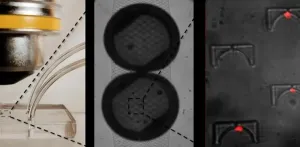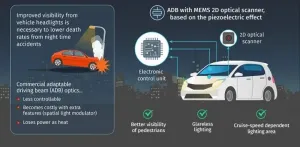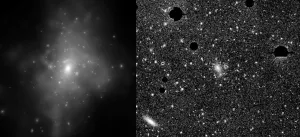(Press-News.org) Perovskites are projected to be a game-changer in future solar technology but currently suffer from a short operational lifespan and drops in efficiency when scaled up to a larger size
Scientists have improved the stability and efficiency of solar cell modules by mixing the precursor materials with ammonium chloride during fabrication
The perovskite active layer in the improved solar modules are thicker and have larger grains, with fewer defects
Both 5 x 5 cm2 and 10 x 10 cm2 perovskite modules maintained high efficiencies for over 1000 hours
Researchers from the Okinawa Institute of Science and Technology Graduate University (OIST) have created perovskite solar modules with improved stability and efficiency by using a new fabrication technique that reduced defects. Their findings were published on the 25th January in Advanced Energy Materials.
Perovskites are one of the most promising materials for the next-generation of solar technology, soaring from efficiencies of 3.8% to 25.5% in slightly over a decade. Perovskite solar cells are cheap to produce and have the potential to be flexible, increasing their versatility. But two obstacles still block the way to commercialization: their lack of long-term stability and difficulties with upscaling.
"Perovskite material is fragile and prone to decomposition, which means the solar cells struggle to maintain high efficiency over a long time," said first author Dr. Guoqing Tong, a postdoctoral scholar in the OIST Energy Materials and Surface Sciences Unit, led by Professor Yabing Qi. "And although small-sized perovskite solar cells have a high efficiency and perform almost as well as their silicon counterparts, once scaled up to larger solar modules, the efficiency drops."
In a functional solar device, the perovskite layer lies in the center, sandwiched between two transport layers and two electrodes. As the active perovskite layer absorbs sunlight, it generates charge carriers which then flow to the electrodes via the transport layers and produce a current.
However, pinholes in the perovskite layer and defects at the boundaries between individual perovskite grains can disrupt the flow of charge carriers from the perovskite layer to the transport layers, reducing efficiency. Humidity and oxygen can also start to degrade the perovskite layer at these defect sites, shortening the lifespan of the device.
"Scaling up is challenging because as the modules increase in size, it's harder to produce a uniform layer of perovskite, and these defects become more pronounced," explained Dr. Tong. "We wanted to find a way of fabricating large modules that addressed these problems."
Currently, most solar cells produced have a thin perovskite layer - only 500 nanometers in thickness. In theory, a thin perovskite layer improves efficiency, as the charge carriers have less distance to travel to reach the transport layers above and below. But when fabricating larger modules, the researchers found that a thin film often developed more defects and pinholes.
The researchers therefore opted to make 5 x 5 cm2 and 10 x 10 cm2 solar modules that contained perovskite films with double the thickness.
However, making thicker perovskite films came with its own set of challenges. Perovskites are a class of materials that are usually formed by reacting many compounds together as a solution and then allowing them to crystallize.
However, the scientists struggled to dissolve a high enough concentration of lead iodine - one of the precursor materials used to form perovskite - that was needed for the thicker films. They also found that the crystallization step was fast and uncontrollable, so the thick films contained many small grains, with more grain boundaries.
The researchers therefore added ammonium chloride to increase the solubility of lead iodine. This also allowed lead iodine to be more evenly dissolved in the organic solvent, resulting in a more uniform perovskite film with much larger grains and fewer defects. Ammonia was later removed from the perovskite solution, lowering the level of impurities within the perovskite film.
Overall, the solar modules sized 5 x 5 cm2 showed an efficiency of 14.55%, up from 13.06% in modules made without ammonium chloride, and were able to work for 1600 hours - over two months - at more than 80% of this efficiency.
The larger 10 x 10 cm2 modules had an efficiency of 10.25% and remained at high levels of efficiency for over 1100 hours, or almost 46 days.
"This is the first time that a lifespan measurement has been reported for perovskite solar modules of this size, which is really exciting," said Dr. Tong.
This work was supported by the OIST Technology Development and Innovation Center's Proof-of-Concept Program. These results are a promising step forward in the quest to produce commercial-sized solar modules with efficiency and stability to match their silicon counterparts.
In the next stage of their research, the team plans to optimize their technique further by fabricating the perovskite solar modules using vapor-based methods, rather than by using solution, and are now trying to scale up to 15 x 15 cm2 modules.
"Going from lab-sized solar cells to 5 x 5 cm2 solar modules was hard. Jumping up to solar modules that were 10 x 10 cm2 was even harder. And going to 15 x 15 cm2 solar modules will be harder still," said Dr. Tong. "But the team is looking forward to the challenge."
INFORMATION:
Plastic is ubiquitous in people's lives. Yet, when plastic-containing items have fulfilled their missions, only a small amount is recycled into new products, which are often of lower quality compared to the original material. And, transforming this waste into high-value chemicals requires substantial energy. Now, researchers reporting in ACS' JACS Au have combined a ruthenium-carbon catalyst and mild, lower-energy reaction conditions to convert plastics used in bottles and other packaging into fuels and chemical feedstock.
Global production of sturdy, single-use plastic for toys, sterile medical packaging, and food and beverage containers is increasing. Polyolefin polymers, such as polyethylene and ...
What makes cancer cells different from ordinary cells in our bodies? Can these differences be used to strike at them and paralyze their activity? Cancer researchers have been debating this question since the mid-19th century.
A new study from Tel Aviv University (TAU) shows, for the first time, how an abnormal number of chromosomes (aneuploidy) -- a unique characteristic of cancer cells that researchers have known about for decades -- could become a weak point for these cells. The study could lead to the development of future drugs that will use this vulnerability to eliminate the cancer cells.
The study was conducted in the laboratory of Dr. Uri Ben-David of TAU's Sackler Faculty of Medicine, in collaboration with six laboratories ...
Cells don't express all the genes they contain all the time. The portion of our genome that encodes eye color, for example, doesn't need to be turned on in liver cells. In plants, genes encoding the structure of a flower can be turned off in cells that will form a leaf.
These unneeded genes are kept from becoming active by being stowed in dense chromatin, a tightly packed bundle of genetic material laced with proteins.
In a new study in the journal Nature Communications, biologists from the University of Pennsylvania identify a protein that enables plant cells to reach these otherwise inaccessible genes in order to switch between different identities. Called ...
Irvine, Calif., Jan. 27, 2021 -- One of President Joe Biden's first post-inauguration acts was to realign the United States with the Paris climate accord, but a new study led by researchers at the University of California, Irvine demonstrates that rising emissions from human land-use will jeopardize the agreement's goals without substantial changes in agricultural practices.
In a paper published today in Nature, the team presented the most thorough inventory yet of land-use contributions to carbon dioxide and other greenhouse gases (including nitrous oxide and methane) from 1961 to 2017, taking into account emissions from agricultural production activities and modifications to the natural landscape.
"We estimated and attributed global land-use emissions among 229 countries ...
Gardeners and farmers around the country recognize that crop varieties grow best in certain regions. Most plant species have adapted to their local environments; for example, crop and ornamental seeds sold for the upper Midwest are often very different than those bred for Texas. Identifying and breeding varieties that have high productivity across a range of environments is becoming increasingly important for food, fuel and other applications, and breeders aren't interested in waiting decades to develop new crops.
One example is an ongoing collaborative effort to improve the emerging bioenergy crop ...
The development of cost-efficient, portable microscopy units would greatly expand their use in remote field locations and in places with fewer resources, potentially leading to easier on-site analysis of contaminants such as E. coli in water sources as well as other practical applications.
Current microscopy systems, like those used to image micro-organisms, are expensive because they are optimized for maximum resolution and minimal deformation of the images the systems produce. But some situations do not require such optimization--for instance, simply detecting the presence of pathogens in water. One potential approach to developing a low-cost portable microscopy system is to use transparent microspheres in combination with affordable ...
In September, a team led by astronomers in the United Kingdom announced that they had detected the chemical phosphine in the thick clouds of Venus. The team's reported detection, based on observations by two Earth-based radio telescopes, surprised many Venus experts. Earth's atmosphere contains small amounts of phosphine, which may be produced by life. Phosphine on Venus generated buzz that the planet, often succinctly touted as a "hellscape," could somehow harbor life within its acidic clouds.
Since that initial claim, other science teams have cast doubt on the reliability of the phosphine ...
Car accidents are responsible for approximately a million deaths each year globally. Among the many causes, driving at night, when vision is most limited, leads to accidents with higher mortality rates than accidents during the day. Therefore, improving visibility during night driving is critical for reducing the number of fatal car accidents.
An adaptive driving beam (ADB) can help to some extent. This advanced drive-assist technology for vehicle headlights can automatically adjust the driver's visibility based on the car speed and traffic environment. ADB systems that ...
A combination of observational data and sophisticated computer simulations have yielded advances in a field of astrophysics that has languished for half a century. The Dark Energy Survey, which is hosted by the U.S. Department of Energy's Fermi National Accelerator Laboratory, has published a burst of new results on what's called intracluster light, or ICL, a faint type of light found inside galaxy clusters.
The first burst of new, precision ICL measurements appeared in a paper published in The Astrophysical Journal in April 2019. Another appeared more recently in Monthly Notices of the Royal Astronomical Society. In a surprise finding of the latter, DES physicists discovered new evidence that ICL might provide a new way to measure a mysterious substance called ...
As surgeons balance the need to control their patients' post-surgery pain with the risk that a routine operation could become the gateway to long-term opioid use or addiction, a new study shows the power of an approach that takes a middle way.
In a new letter in JAMA Surgery, a team from Michigan Medicine at the University of Michigan reports on findings from a study of 620 patients who had surgery in hospitals across Michigan, had their painkiller use tracked, and took surveys within one to three months after their operations.
Half of the patients received pre-surgery counseling that emphasized non-opioid pain treatment as their first option. Some patients in this group received small, "just in case" prescriptions, but a third of them didn't receive any opioid prescription ...





